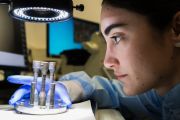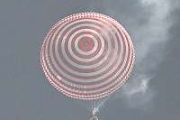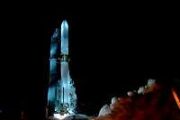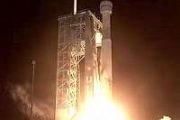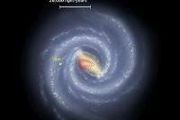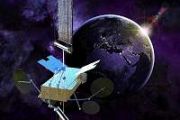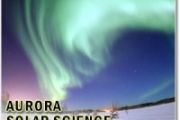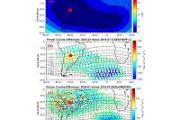
Copernical Team
Micro-world within atomic clock
 Image:
Micro-world within atomic clock
Image:
Micro-world within atomic clock Three iron rings in a planet-forming disk
 A research team, including astronomers of the Max Planck Institute for Astronomy (MPIA), has detected a three-ringed structure in the nursery of planets in the inner planet-forming disk of a young star. This configuration suggests two Jupiter-mass planets are forming in the gaps between the rings. The detailed analysis is consistent with abundant solid iron grains complementing the dust composit
A research team, including astronomers of the Max Planck Institute for Astronomy (MPIA), has detected a three-ringed structure in the nursery of planets in the inner planet-forming disk of a young star. This configuration suggests two Jupiter-mass planets are forming in the gaps between the rings. The detailed analysis is consistent with abundant solid iron grains complementing the dust composit Euroconsult forecasts $75 Billion in growth for Middle East's Space Sector by 2032
 As the global space industry undergoes substantial shifts marked by evolving market dynamics, technological advancements, and geopolitical changes, a new comprehensive white paper from Euroconsult, a leader in space sector strategy consulting and market intelligence, sheds light on an emerging powerhouse: the Middle East's space ecosystem. Titled "Beyond the Stars: The Middle East's Space Ecosys
As the global space industry undergoes substantial shifts marked by evolving market dynamics, technological advancements, and geopolitical changes, a new comprehensive white paper from Euroconsult, a leader in space sector strategy consulting and market intelligence, sheds light on an emerging powerhouse: the Middle East's space ecosystem. Titled "Beyond the Stars: The Middle East's Space Ecosys Researchers 3D print components for a portable mass spectrometer
 Mass spectrometers, devices that identify chemical substances, are widely used in applications like crime scene analysis, toxicology testing, and geological surveying. But these machines are bulky, expensive, and easy to damage, which limits where they can be effectively deployed.
Using additive manufacturing, MIT researchers produced a mass filter, which is the core component of a mass sp
Mass spectrometers, devices that identify chemical substances, are widely used in applications like crime scene analysis, toxicology testing, and geological surveying. But these machines are bulky, expensive, and easy to damage, which limits where they can be effectively deployed.
Using additive manufacturing, MIT researchers produced a mass filter, which is the core component of a mass sp Evolution of photosynthesis expanded with discovery of oldest thylakoids in a fossil cyanobacteria
 Researchers at the University of Liege (ULiege) have identified microstructures in fossil cells that are 1.75 billion years old. These structures, called thylakoid membranes, are the oldest ever discovered. They push back the fossil record of thylakoids by 1.2 billion years and provide new information on the evolution of cyanobacteria which played a crucial role in the accumulation of oxygen on
Researchers at the University of Liege (ULiege) have identified microstructures in fossil cells that are 1.75 billion years old. These structures, called thylakoid membranes, are the oldest ever discovered. They push back the fossil record of thylakoids by 1.2 billion years and provide new information on the evolution of cyanobacteria which played a crucial role in the accumulation of oxygen on Wiseband and Rivada Space Networks join forces for Middle Eastern network expansion
 In a significant move for the Middle Eastern telecommunications sector, Rivada Space Networks has announced a partnership with Emirati satellite services company Wiseband. This collaboration aims to introduce Rivada's advanced low-earth-orbit (LEO) satellite technology, the OuterNET, to the Middle East, enhancing secure connectivity in the region.
Rivada Space Networks, renowned for its pi
In a significant move for the Middle Eastern telecommunications sector, Rivada Space Networks has announced a partnership with Emirati satellite services company Wiseband. This collaboration aims to introduce Rivada's advanced low-earth-orbit (LEO) satellite technology, the OuterNET, to the Middle East, enhancing secure connectivity in the region.
Rivada Space Networks, renowned for its pi USSF Conducts First Exercise RED SKIES, Elevating Orbital Warfare Readiness
 In a significant advancement for the United States Space Force (USSF), the inaugural Exercise RED SKIES, conducted from December 11-15, marked a new era in space operations and readiness. This exercise underscores the USSF's commitment to developing robust capabilities in the realm of Orbital Warfare (OW), an increasingly vital aspect of national security.
Hosted by the Space Training and
In a significant advancement for the United States Space Force (USSF), the inaugural Exercise RED SKIES, conducted from December 11-15, marked a new era in space operations and readiness. This exercise underscores the USSF's commitment to developing robust capabilities in the realm of Orbital Warfare (OW), an increasingly vital aspect of national security.
Hosted by the Space Training and SSC and Microsoft building space simulation and wargaming platform for Space Force
 Space Systems Command (SSC), a pivotal entity within the U.S. Space Force, recently announced the continuation of its partnership with Microsoft Corporation (NASDAQ: MSFT) to bolster Space Force missions through advanced technology. This collaboration focuses on the development of the Integrated, Immersive, Intelligent Environment (I3E), an ambitious follow-on to the previously successful Immers
Space Systems Command (SSC), a pivotal entity within the U.S. Space Force, recently announced the continuation of its partnership with Microsoft Corporation (NASDAQ: MSFT) to bolster Space Force missions through advanced technology. This collaboration focuses on the development of the Integrated, Immersive, Intelligent Environment (I3E), an ambitious follow-on to the previously successful Immers New Study Reinforces Evidence for Modified Gravity in Wide Binary Star Systems
 A recent publication in the Astrophysical Journal has introduced new findings that suggest a significant deviation from standard gravity in wide binary star systems, particularly at lower accelerations. This study, led by Kyu-Hyun Chae, a professor of physics and astronomy at Sejong University, Seoul, utilized observations from the European Space Agency's Gaia space telescope to analyze the moti
A recent publication in the Astrophysical Journal has introduced new findings that suggest a significant deviation from standard gravity in wide binary star systems, particularly at lower accelerations. This study, led by Kyu-Hyun Chae, a professor of physics and astronomy at Sejong University, Seoul, utilized observations from the European Space Agency's Gaia space telescope to analyze the moti Astronomers Discover Early Ring and Spiral Structures in Young Planetary Disks
 In a significant advancement in our understanding of planetary formation, an international team of astronomers has uncovered ring and spiral structures in exceptionally young planetary disks. This discovery, presented at the 243rd Meeting of the American Astronomical Society, suggests that the process of planet formation may commence much sooner than previously believed.
The team, utilizin
In a significant advancement in our understanding of planetary formation, an international team of astronomers has uncovered ring and spiral structures in exceptionally young planetary disks. This discovery, presented at the 243rd Meeting of the American Astronomical Society, suggests that the process of planet formation may commence much sooner than previously believed.
The team, utilizin 

